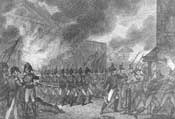Washington DC - War of 1812 Burning

Immediately after the battle, the British sent an advance guard of soldiers to Capitol Hill. Major General Ross sent a party under a flag of truce to agree to terms, but they were attacked by citizens from a house at the corner of Maryland and Constitution Avenue. This was the only resistance the soldiers met within the city. The house was burned and the British raised their Union Flag over Washington. They then turned their sights on the buildings housing the Senate, the House of Representatives and the Library of Congress- which were set on fire and destroyed.
The soldiers burned the President's house (then called the Executive Mansion, later the White House). British troops added fuel to the fires that night to ensure they would continue burning into the next day. The smoke was reportedly visible as far away as Baltimore. The day after the destruction of the White House, Rear Admiral Cockburn entered the building of the newspaper- the National Intelligencer- intending to burn it down. Cockburn wanted to destroy the operation because its reporters had written so negatively about him. Some local women persuaded him to stop because they were concerned the fire would spread to their neighboring houses. Cockburn relented, but ordered his troops to tear the structure down brick by brick, ordering all the "C" letters in the type destroyed "so that the rascals can have no further means of abusing my name".
The British also burned the United States Treasury and other public buildings. The U.S. Patent Office was saved by the efforts of William Thornton, the architect of the Capitol, who pleaded for British cooperation to preserve it. With major portions of the city in flames, it seemed only a miracle could save the metropolis and its desperate citizens. It seems the good Lord heard their cries. A drenching rain doused the Capitol that night, saving the remainder of the area from ruin, but leaving the town a smoldering ruin.
